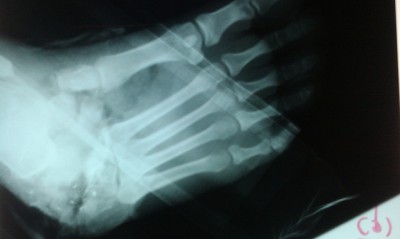
A lot of attention is being given to helmet safety for winter sports, but it is also important to protect your feet and ankles during these activities as well. Left untreated, ankle sprains or fractures can lead to chronic ankle instability and repeated injury. According to the National Sportings Goods Association, 9.2 million people skied and 5.1 million people snowboarded in 2011. That same year, the US Consumer Products Safety Commission estimates these two sports resulted in 83,580 injuries.
Ankle sprains and talus fractures are the most common skiing and snowboarding foot and ankle injuries. Snowboarders even have an injury named after their sport. Snowboarders Ankle is actually a lateral talus fracture. The talus is the bone in the back of the foot between the bottom of the two leg bones, the tibia and the fibula, and the top of the foot. This fracture occurs from a combination of two motions – dorsiflexion of the foot, where the foot bends up toward the leg; and ankle inversion, or rolling the ankle under the foot. Symptoms include pain, bruising and swelling of the ankle, and difficulty walking. Treatment can include a cast or, in some cases, surgery. As snowboarding has increased in popularity, this fracture has become much more common but is often misdiagnosed as a sprain.
Jeffrey Johnson, MD, is Professor of Orthopedic Surgery and Chief of the Foot and Ankle Service atWashington University School of Medicine in St. Louis, MO and Treasurer of the American Orthopaedic Foot & Ankle Society. He suggests, “If you think you have suffered an ankle sprain and you still cannot bear weight on the ankle after a day or two of rest, ice and a compressive wrap, or are not improving in therapy, you should see your doctor and have an exam and an x-ray. There are many types of injuries to the foot and ankle that happen like a sprain and an accurate diagnosis will help direct the proper treatment.”
Ankle sprains and fractures often have the same symptoms. An ankle sprain also occurs on the outside of the ankle during an inversion injury. A sprain is the result of stretched or torn ligaments instead of broken bones. Sprains are rated into grades based on the degree of damage to the ligaments. Often, people are unable to bear weight on that leg and there is a lot of swelling and pain initially. Sprained ankles are treated with RICE – rest, ice, compression and elevation for the first 48 to 72 hours. Severe sprains might require a walking boot.
Whether the ankle is sprained or broken, recovery will take time. Exercises to strengthen and stretch the ankle will help, along with wearing an ankle brace for support. It is important to gradually return to full activity and to rehabilitate the ankle to avoid chronic ankle instability.
What can you do to avoid these injuries?
- Wear the correct boot for the sport. Snowboarders should wear firm boots which limit ankle motion and fit snugly.
- Keep an eye on the other skiiers, snowboarders and the terrain you are on
- Obtain proper instruction and don’t imitate the extreme stunts you see on television
- Never go out alone; have a buddy with you if you get hurt
- See an orthopaedic foot and ankle surgeon if you have any ankle pain that lasts for more than 72 hours or swelling that doesn’t go away after 24 hours.
For more information on how to care for ankle injuries, or to find a local orthopaedic foot and ankle surgeon, visit footcaremd.org.
 Your Privacy Choices
Your Privacy Choices
 The
The